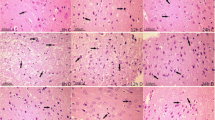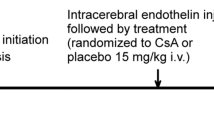Abstract
Phospholipase A2s (PLA2s) seem to be involved in the pathophysiology of ischemic brain injury, but their specific role is far from being completely understood. The present study was carried out to ascertain how and to what extent secretory PLA2s (sPLA2s) activity influences outcome after cerebral ischemia–reperfusion, and to correlate this with the inflammatory response. To do this we used the potent and selective sPLA2 inhibitor, 12-epi-scalaradial. Male Wistar rats were separated into three groups: a control group receiving intracerebroventricular vehicle, and two groups receiving intracerebroventricular 0.005 or 0.5 μg/h 12-epi-scalaradial. Every animal was subjected to middle cerebral artery (MCA) occlusion (90 min, intraluminal thread technique) under continuous monitorization of cerebrocortical perfusion (CP, laser-Doppler flowmetry), followed by reperfusion (3 days). Neurological status, infarct volume, and myeloperoxidase (MPO) activity were the main end points. Three days after the 90-min ischemia period, neurological examination did not reveal significant differences between the three groups of rats. Control rats showed a mean infarct volume of 145.9 ± 24.7 mm3 (21 ± 4.1% of the ipsilateral hemisphere volume), while mean infarct volume in rats treated with 0.005 or 0.5 μg/h 12-epi-scalaradial increased to 164.8 ± 86.8 mm3 (22.0 ± 10.9%) and 211.5 ± 12.2 mm3 (28 ± 3%, P < 0.05), respectively. Treatment with the highest dose of 12-epi-scalaradial (0.5 μg/h) increased MPO activity in the ipsilateral hemisphere by about 140% (from 0.59 ± 0.59 to 1.42 ± 1.03 units of activity/g of tissue in comparison with the control ischemic hemisphere, P < 0.05). Overall, our results point to a positive rather than a negative influence of sPLA2 activity during ischemia. This, along with its inability to decrease the inflammatory response, does not allow to propose the use of 12-epi-scalardial as a potential drug for stroke therapy.





Similar content being viewed by others

References
Adibhatla RM, Hatcher JF (2002) Citicoline mechanisms and clinical efficacy in cerebral ischemia. J Neurosci Res 70:133–139
Adibhatla RM, Hatcher JF (2003) Citicoline decreases phospholipase A2 stimulation and hydroxyl radical generation in transient cerebral ischemia. J Neurosci Res 73:308–315
Arnhold J, Furtmüller PG, Obinger C (2003) Redox properties of myeloperoxidase. Redox Rep 8:179–186
Barone FC, Hillegass LM, Price WJ, White RF, Lee EV, Feuerstein GZ, Sarau HM, Clark RK, Griswold DE (1991) Polymorphonuclear leukocyte infiltration into cerebral focal ischemic tissue: myeloperoxidase activity assay and histologic verification. J Neurosci Res 29:336–345
Bazan NG (2005) Neuroprotectin D1 (NPD1): a DHA-derived mediator that protects brain and retina against cell injury-induced oxidative stress. Brain Pathol 15:159–166
Bazan NG, Allan G, Rodriguez de Turco EB (1993) Role of phospholipase A2 and membrane-derived lipid second messengers in membrane function and transcriptional activation of genes: implications in cerebral ischemia and neuronal excitability. In: Kogure K, Hossmann K-A, Siesjö BK (eds) Progress in brain research, vol 96, chap. 17. Elsevier, Amsterdam, pp 247–257
Bederson JB, Pitts LH, Germano SM, Nishimura MC, Davis RL, Bartkowski HM (1986) Evaluation of 2,3,5-triphenyltetrazolium chloride as a stain for detection and quantification of experimental cerebral infarction in rats. Stroke 17:1304–1308
Blackwell GJ, Flower RJ (1983) Inhibition of phospholipase. Br Med Bull 39:260–264
Blondeau N, Lauritzen I, Widmann C, Lazdunski M, Herteaux C (2002) A potent protective role of lysophospholipids against global cerebral ischemia and glutamate excitotoxicity in neuronal cultures. J Cereb Blood Flow Metab 22:821–834
Čopič A, Vučemilo N, Gubenšek F, Križaj I (1999) Identification and purification of a novel receptor for secretory phospholipase A2 in porcine cerebral cortex. J Biol Chem 274:26315–26320
Cunningham TJ, Souayah N, Jameson B, Mitchell J, Yao L (2004) Systemic treatment of cerebral cortex lesions in rats with a new secreted phospholipase A2 inhibitor. J Neurotrauma 21:1683–1691
Danton GH, Dietrich WD (2003) Inflammatory mechanisms after ischemia and stroke. J Neuropathol Exp Neurol 62:127–136
De Carvalho MS, Jacobs RS (1991) Two-step inactivation of bee venom phospholipase A2 by scalaradial. Biochem Pharmacol 42:1621–1626
Estevez AY, Phillis JW (1997) The phospholipase inhibitor, quinacrine, reduces infarct size in rats after transient middle cerebral artery occlusion. Brain Res 752:203–208
Fagan SC, Hess DC, Hohnadel EJ, Pollock DM, Ergul A (2004) Targets for vascular protection after acute ischemic stroke. Stroke 35:2220–2225
Farooqui AA, Ong W-Y, Horrocks LA (2004) Neuroprotection abilities of cytosolic phospholipase A2 inhibitors in kainic acid-induced neurodegeneration. Curr Drug Targets Cardiovasc Haematol Disord 4:85–96
Granata F, Petraroli A, Boilard E, Bezzine S, Bollinger J, Del Vecchio L, Gelb MH, Lambeau G, Marone G, Triggiani M (2005) Activation of cytokine production by secreted phospholipase A2 in human lung macrophages expressing the M-type receptor. J Immunol 174:464–474
Hirabayashi T, Murayama T, Shimizu T (2004) Regulatory mechanisms and physiological role of cytosolic phospholipase A2. Biol Pharm Bull 27:1168–1173
Kaminska B (2005) MAPK signalling pathways as molecular targets for anti-inflammatory therapy—from molecular mechanisms to therapeutic benefits. Biochim Biophys Acta 1745:253–262
Kolko M, DeCoster MA, Rodríguez de Turco E, Bazan NG (1996) Synergy by secretory phospholipase A2 and glutamate on inducing cell death and sustained arachidonic acid metabolic changes in primary cortical neuronal cultures. J Biol Chem 271:32722–32728
Kolko M, Rodriguez de Turco EB, Diemer NH, Bazan NG (2002) Secretory phospholipase A2-mediated neuronal cell death involves glutamate ionotropic receptors. NeuroReport 13:1963–1966
Lin T-N, Wang Q, Simonyi A, Chen J-J, Cheung W-M, He YY, Xu J, Sun AY, Hsu CY, Sun GY (2004) Induction of secretory phospholipase A2 in reactive astrocytes in response to transient focal cerebral ischemia in the rat brain. J Neurochem 90:637–645
Longa EZ, Weinstein PR, Carlson S, Cummins R (1989) Reversible middle cerebral artery occlusion without craniectomy in rats. Stroke 20:84–91
Marshall LA, Winkler JD, Griswold DE, Bolognese B, Roshak A, Sung C-M, Webb EF, Jacobs R (1994) Effects of scalaradial, a type II phospholipase A2 inhibitor, on human neutrophil arachidonic acid mobilization and lipid mediator formation. J Pharmacol Exp Ther 268:709–717
Meyer MC, Rastogi P, Beckett CS, McHowat J (2005) Phospholipase A2 inhibitors as potential anti-inflammatory agents. Curr Pharm Des 11:1301–1312
Miettinen S, Fusco FR, Yrjänheikki J, Keinänen R, Hir Vonen T, Roivainen R, Närhi M, Hökfelt T, Koistinaho J (1997) Spreading depression and focal brain ischemia induce cyclooxigenase-2 in cortical neurons through N-methyl-d-aspartic acid-receptors and phospholipase A2. Proc Natl Acad Sci USA 94:6500–6505
Monti MC, Casapullo A, Riccio R, Gomez-Paloma L (2005) The inactivation of phospholipase A2 by scalaradial: a biomimetic study by electrospray mass spectrometry. Rapid Commun Mass Spectrom 19:303–308
Mounier CM, Ghomashchi F, Lindsay MR, James S, Singer AG, Parton RG, Gelb MH (2004) Arachidonic acid release from mammalian cells transfected with human groups IIA and X secreted phospholipase A2 occurs predominantly during the secretory process and with the involvement of cytosolic phospholipase A2-α. J Biol Chem 279:25024–25038
Murakami M (2004) Hot topics in phospholipase A2 field. Biol Pharm Bull 27:1179–1182
Murakami M, Kudo I (2004) Secretory phospholipase A2. Biol Pharm Bull 27:1158–1164
Nevalainen TJ, Haapamäki MM, Grönroos JM (2000) Roles of secretory phospholipase A2 in inflammatory diseases and trauma. Biochim Biophys Acta 1488:83–90
Payá M, Terencio MC, Ferrándiz ML, Alcaraz MJ (1996) Involvement of secretory phospholipase A2 activity in the zymosan rat air pouch model of inflammation. Br J Pharmacol 117:1773–1779
Phillis JW, O’Reagan MH (2004) A potential critical role of phospholipases in central nervous system ischemic, traumatic, and neurodegenerative disorders. Brain Res 44:13–47
Pilitsis JG, Diaz FG, O’Regan MH, Phillis JW (2002) Differential effects of phospholipase inhibitors on free fatty acid efflux in rat cerebral cortex during ischemia–reperfusion injury. Brain Res 951:96–106
Pinto F, Brenner T, Dan P, Krimsky M, Yedgar S (2003) Extracellular phospholipase A2 inhibitors suppress central nervous system inflammation. Glia 44:275–282
Rosenberger TA, Villacreses NE, Contreras MA, Bonventre JV, Rapoport SI (2003) Brain lipid metabolism in the cPLA2 knockout mouse. J Lipid Res 44:109–117
Sapirstein A, Bonventre JV (2000) Specific physiological roles of cytosolic phospholipase A2 as defined by gene knockouts. Biochim Biophys Acta 1488:139–148
Six DA, Dennis EA (2000) The expanding superfamily of phospholipase A2 enzymes: classification and characterization. Biochim Biophys Acta 1488:1–19
Smart BP, Pan YH, Weeks AK, Bollinger JG, Bahnson BJ, Gelb MH (2004) Inhibition of the complete set of mammalian secreted phospholipase A2 by indole analogues—a structure-guided study. Bioorgan Med Chem 12:1737–1749
Šribar J, Čopič A, Pariš A, Sherman NE, Gubenšek F, Fox JW, Križaj I (2001) A high affinity acceptor for phospholipase A2 with neurotoxic activity is a calmodulin. J Biol Chem 276:12493–12496
Sun GY, Xu J, Jensen MD, Simonyi A (2004) Phospholipase A2 in the central nervous system: implications for neurodegenerative diseases. J Lipid Res 45:205–213
Suzuki N, Ishizaki J, Yokota Y, Higashino K-I, Ono T, Ikeda M, Fujii N, Kawamoto K, Hanasaki K (2000) Structures, enzymatic properties, and expression of novel human and mouse secretory phospholipase A2s. J Biol Chem 275:5785–5793
Tabuchi S, Uozumi N, Ishii S, Shimizu Y, Watanabe T, Shimizu T (2003) Mice deficient in cytosolic phospholipase A2 are less susceptible to cerebral ischemia/reperfusion injury. Acta Neurochir 86(Suppl):169–172
Thommesen L, Sjursen W, Gåsvik K, Hanssen W, Brekke O-L, Skattebøl L, Holmeide AK, Espevik T, Johansen B, Lægreid A (1998) Selective inhibitors of cytosolic or secretory phospholipase A2 block TNF-induced activation of transcription factor nuclear factor-κB and expression of ICAM-1. J Immunol 161:3421–3430
Thwin M-M, Ong W-Y, Fong C-W, Sato K, Kodama K, Farooqui AA, Gopalakrishnakone P (2003) Secretory phospholipase A2 activity in the normal and kainate injected rat brain, and inhibition by a peptide derived from python serum. Exp Brain Res 150:427–433
Wei S, Ong WY, Thwin MM, Fong CW, Farooqui AA, Gopalakrishnakone P, Hong W (2003) Group IIA secretory phospholipase A2 stimulates exocytosis and neurotransmitter release in pheochromocytoma-12 cells and cultured rat hippocampal neurons. Neuroscience 121:891–898
Xiao YF, Zeind AJ, Kaushi V, Perreault-Micale CL, Morgan JP (2000) Mechanism of suppression of cardiac L-type Ca2+ currents by phospholipase A2 inhibitor mepacrine. Eur J Pharmacol 7:107–116
Xie Y, Liu L, Huang X, Guo Y, Lou L (2005) Scalaradial inhibition of epidermal growth factor receptor-mediated Akt phosphorylation is independent of secretory phospholipase A2. J Pharmacol Exp Ther 314:1210–1217
Yagami T, Ueda K, Asakura K, Hata S, Kuroda T, Sakaeda T, Takasu N, Tanaka K, Gemba T, Hori Y (2002) Human group IIA secretory phospholipase A2 induces neuronal cell death via apoptosis. Mol Pharmacol 61:114–126
Yagami T, Ueda K, Asakura K, Okamura N, Sakaeda T, Sakaguchi G, Itoh N, Hashimoto Y, Nakano T, Fujimoto M (2003) Effect of Gas6 on secretory phospholipase A2-IIA-induced apoptosis in cortical neurons. Brain Res 985:142–149
Yeo J-F, Ong W-Y, Ling S-F, Farooqui AA (2004) Intracerebroventricular injection of phospholipase A2 inhibitors modulates allodynia after facial carrageenan injection in mice. Pain 112:148–155
Yokota Y, Hanasaki K, Ono T, Nakazato H, Kobayashi T, Arita H (1999) Suppression of murine endotoxic shock by sPLA2 inhibitor, indoxam, through group IIA sPLA2-independent mechanisms. Biochim Biophys Acta 1438:213–222
Zhang Y, Lemasters J, Herman B (1999) Secretory group IIA phospholipase A2 generates anti-apoptotic survival signals in kidney fibroblasts. J Biol Chem 274:27726–27733
Acknowledgements
The authors thank Ms. María del Carmen Tirados and María del Carmen Máñez for technical assistance. The present work was partially supported by a grant from Ministerio de Ciencia y Tecnología (SAF98-0033). Fernando J. Pérez-Asensio is supported by Centro de Investigación de Enfermedades Neurológicas (CIEN), Ministerio de Sanidad y Consumo (C03/06). María C. Burguete is supported by Ministerio de Ciencia y Tecnología (SAF2001-0398). María Castelló-Ruiz is supported by Fondo de Investigación Sanitaria (FIS, PI030323), Ministerio de Sanidad y Consumo.
Author information
Authors and Affiliations
Corresponding author
Rights and permissions
About this article
Cite this article
Torregrosa, G., Pérez-Asensio, F.J., Burguete, M.C. et al. Chronic intracerebroventricular delivery of the secretory phospholipase A2 inhibitor, 12-epi-scalaradial, does not improve outcome after focal cerebral ischemia–reperfusion in rats. Exp Brain Res 176, 248–259 (2007). https://doi.org/10.1007/s00221-006-0611-7
Received:
Accepted:
Published:
Issue Date:
DOI: https://doi.org/10.1007/s00221-006-0611-7



